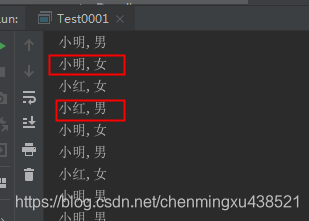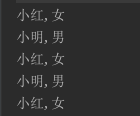一、什么是多线程之间的通讯
1.概念:多线程之间通讯,其实就是多个线程在操作同一个资源,但是操作的动作不同。
二、多线程通讯模拟出现的问题
1.需求:第一个线程写入(input)用户,另一个线程取读取(out)用户.实现读一个,写一个操作。
2.代码
// 共享对象
class Res {
// 姓名
public String name;
// 性别
public String sex;
}
// 生产这线程
class IntThread extends Thread {
public Res res;
public IntThread(Res res) {
this.res = res;
}
@Override
public void run() {
int count = 0; // 1
while (true) {
if (count == 0) {
res.name = "小红";
res.sex = "女";
} else {
res.name = "小明";
res.sex = "男";
}
count = (count + 1) % 2;// 0 1 0 1 0 1
}
}
}
// 读取线程
class OutThread extends Thread {
public Res res;
public OutThread(Res res) {
this.res = res;
}
@Override
public void run() {
while (true) {
System.out.println(res.name + "," + res.sex);
}
}
}
public class Test0001 {
public static void main(String[] args) throws InterruptedException {
Res res = new Res();
IntThread intThread = new IntThread(res);
OutThread outThread = new OutThread(res);
intThread.start();
outThread.start();
}
}3.结果

注意:数据发生错乱,造成线程安全问题
三、多线程通讯模拟解决问题
1.代码
// 共享对象
class Res {
// 姓名
public String name;
// 性别
public String sex;
// 为true情况下 允许读,不能写
// 为false情况下 允许写,不能读。
public boolean flag = false;
}
// 生产这线程
class IntThread extends Thread {
public Res res;
public IntThread(Res res) {
this.res = res;
}
@Override
public void run() {
int count = 0; // 1
while (true) {
synchronized (res) {
if (res.flag) {
try {
res.wait();// 釋放当前锁对象
} catch (Exception e) {
// TODO: handle exception
}
}
if (count == 0) {
res.name = "小红";
res.sex = "女";
} else {
res.name = "小明";
res.sex = "男";
}
count = (count + 1) % 2;// 0 1 0 1 0 1
res.flag = true;// 标记当前线程为等待
res.notify();// 唤醒被等待的线程
}
}
}
}
// 读取线程
class OutThread extends Thread {
public Res res;
public OutThread(Res res) {
this.res = res;
}
@Override
public void run() {
while (true) {
synchronized (res) {
try {
if (!res.flag) {
res.wait();
}
Thread.sleep(1000);
} catch (Exception e) {
// TODO: handle exception
}
System.out.println(res.name + "," + res.sex);
res.flag = false;
res.notify();
}
}
}
}
public class Test0001 {
public synchronized static void main(String[] args) throws InterruptedException {
Res res = new Res();
IntThread intThread = new IntThread(res);
OutThread outThread = new OutThread(res);
intThread.start();
outThread.start();
}
}2.结果

3.分析
3.1.因为涉及到对象锁,他们必须都放在synchronized中来使用. Wait、Notify一定要在synchronized里面进行使用。
3.2.Wait必须暂定当前正在执行的线程,并释放资源锁,让其他线程可以有机会运行。
注意:一定要在线程同步中使用,并且是同一个锁的资源
四、小福利
1.wait与sleep的区别
对于sleep()方法,我们首先要知道该方法是属于Thread类中的。而wait()方法,则是属于Object类中的。
sleep()方法导致了程序暂停执行指定的时间,让出cpu该其他线程,但是他的监控状态依然保持者,当指定的时间到了又会自动恢复运行状态。
在调用sleep()方法的过程中,线程不会释放对象锁。
而当调用wait()方法的时候,线程会放弃对象锁,进入等待此对象的等待锁定池,只有针对此对象调用notify()方法后本线程才进入对象锁定池准备,获取对象锁进入运行状态。
五、结束
Always keep the faith!!!
